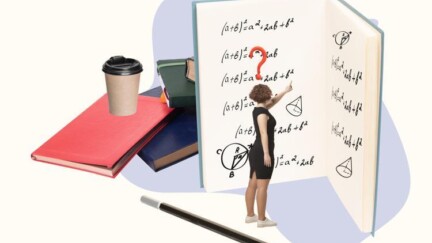GMAT-Testaufgaben: Übungen zur Selbsteinschätzung für den GMAT

master1305 – stock.adobe.com
Wer eine gute bis sehr gute Punktzahl im GMAT erreichen möchte, sollte sich gut vorbereiten. Es gibt viele Anbieter und auch Bücher für das Selbststudium. Hier kannst du dich anhand von ein paar Testaufgaben einschätzen.
Beispiel für Data Sufficiency
"Jim and Carol ran a 500-kilometer race. What was Jim's average running speed?"
(1) Jim completed the race in 6 hours and 40 minutes.
(2)
Carol, at an average speed of 100 kilometers per hour, completed the
race 1 hour and 40 minutes before Jim crossed the finish line.
A Statement (1) ALONE is sufficient, but statement (2) alone is not sufficient.
B Statement (2) ALONE is sufficient, but statement (1) alone is not sufficient.
C BOTH statements TOGETHER are sufficient, but NEITHER statement ALONE is sufficient.
D EACH statement ALONE is sufficient.
E Statements (1) and (2) TOGETHER are NOT sufficient.
Die richtige Antwort ist
D
Quelle: Kursmaterial von Manhattan Review, einem Anbieter von GMAT-Vorbereitungskursen.
Beispiel für Problem Solving
"Catherine went shopping with D dollars. She spent 20 per cent of her
money on a dress and 25 per cent of what was left on a pair of black
shoes. What per cent of the original D dollars did she spend?"
A 25%
B 40%
C 45%
D 47%
E 50%
Die richtige Antwort ist
B
Quelle: Kursmaterial von Manhattan Review, einem Anbieter von GMAT-Vorbereitungskursen.
Beispiel für Sentence Correction
"At the young age of 25, Tiger Woods all others in the sport."
A has become the dominant golf player of our time, surpassing
B has become the dominant golf player of our time, by replacing
C having become the dominant golf player of our time, and he surpassed
D in his becoming a dominant golf player of our time, defeated
E has become the dominant golf player of our time, with the surpassing of
Die richtige Antwort ist
A
Quelle: Kursmaterial von Manhattan Review, einem Anbieter von GMAT-Vorbereitungskursen.
Beispiel für Critical Reasoning
"Consumer watch experts maintain that with each 1% increase in the number of computer sales, there is a correlative 3% increase in the number of computer video game sales. However, in the last ten years, there was only one year of an extremely high increase in the number of video game sales and during that year, there was no increase in the number of computer sales."
Which of the following conclusions can properly be drawn from the statements above?
A Consumer experts are incorrect in their assertion that the sale of video games is related to the sale of computers.
B The consumer experts neglected to consider the difference in the number of laptop computers and desktop computers sold.
C The high number of video games sold was a result of a strong economy and increased wages during that year.
D The ten-year period in question is not representative of normal consumer behavior.
E The number of computer sales is not the only factor affecting how many video games people buy.
Die richtige Antwort ist
E
Quelle: Kursmaterial von Manhattan Review, einem Anbieter von GMAT-Vorbereitungskurse
Beispiel für Reading Comprehension
"The founders of the Republic viewed their revolution primarily in political rather than economic or social terms. And they talked about education as essential to the public good - a goal that took precedence over knowledge as occupational training or as a means to self-fulfillment or self-improvement. Over and over again the Revolutionary generation, both liberal and conservative in outlook, asserted its conviction that the welfare of the Republic rested upon an educated citizenry and that schools, especially free public schools, would be the best means of educating the citizenry in civic values and the obligations required of everyone in a democratic republican society. All agreed that principal ingredients of a civic education were literacy and the inculcation of patriotic and moral virtues, some others adding the study of history and the study of principles of the republican government itself.
The founders, as was the case of almost all their successors, were long on exhortation and rhetoric regarding the value of civic education, but they left it to the textbook writers to distill the essence of those values for school children. Texts in American history and government appeared as early as the 1790s. The textbook writers turned out to be very largely of conservative persuasion, more likely Federalist in outlook than Jeffersonian, and almost universally agreed that political virtue must rest upon moral and religious precepts. Since most textbooks writers were New Englander, this meant that the texts were infused with Protestant and, above all, Puritan outlooks. In the first half of the Republic, civic education in the schools emphasized the inculcation of civic values and made little attempt to develop participatory political skills. That was the task left to incipient political parties, town meetings, churches and the coffee or ale houses where men gathered for conservation. Additionally as a reading of certain Federalist papers of the period would demonstrate, the press probably did more to disseminate realistic as well as partisan knowledge of government than the schools. The goal of education, however, was to achieve a higher form of union for the new Republic. In the middle half of the nineteenth century, the political values taught in the public and private schools did not change substantially from those celebrated in the first fifty years of the Republic. In the textbooks of the day their rosy hues if anything became golden. To the resplendent values of liberty, equality, and a benevolent Christian morality were now added the middle-class virtues - especially of New England - of hard work, honesty and integrity, the rewards of individual effort, and obedience to parents and legitimate authority. But of all the political values taught in school, patriotism was preeminent; and whenever teachers explained to school children why they should love their country above all else, the idea of liberty assumed pride of place."
1. The passage deals primarily with the
A content of early textbooks on American history and government
B role of education in the late eighteenth- and early to mid-nineteenth-century America
C influence of New England Puritanism on early American values
D origin and development of the Protestant work ethic in modern America
E establishment of universal free public education in America
Die richtige Antwort ist
A
2. According to the passage, the founders of the Republic regarded education primarily as
A a religious obligation
B a private matter
C an unnecessary luxury
D a matter of individual choice
E a political necessity
Die richtige Antwort ist
E
Quelle: Kursmaterial von Manhattan Review, einem Anbieter von GMAT-Vorbereitungskursen.


![Frau steht in einem Computer und lächelt [© dodotone – stock.adobe.com]](https://www.e-fellows.net/uploads/NEU-Medienbibliothek/Symbolbilder/_card/3220361/Frau-Darstellung-Bewerbung.jpg)





